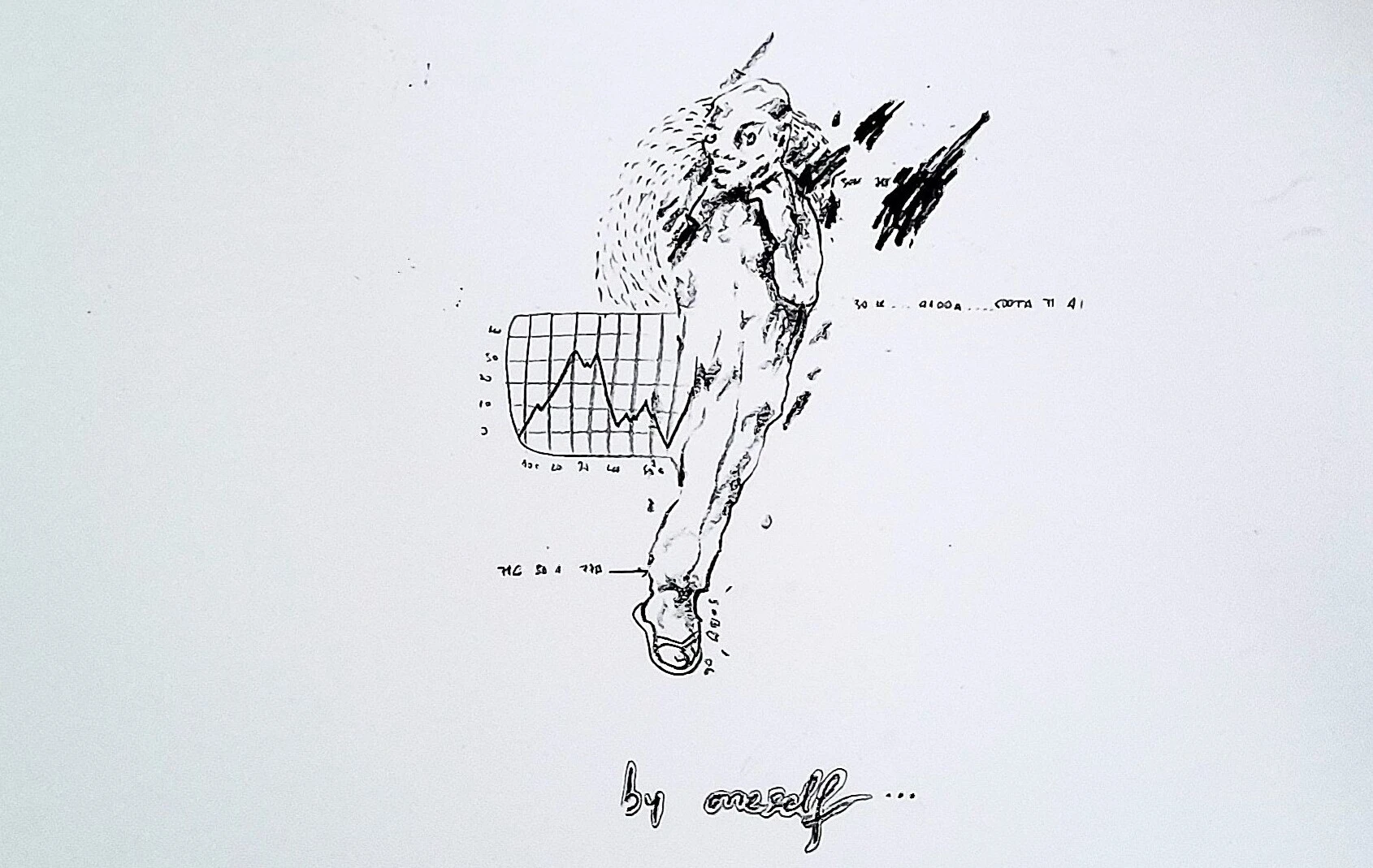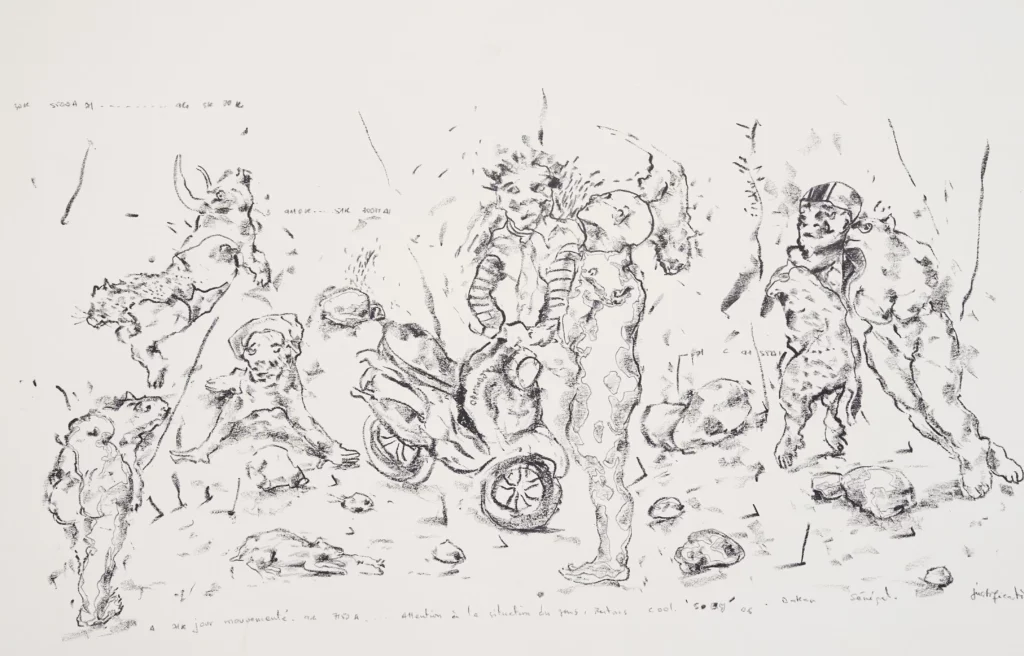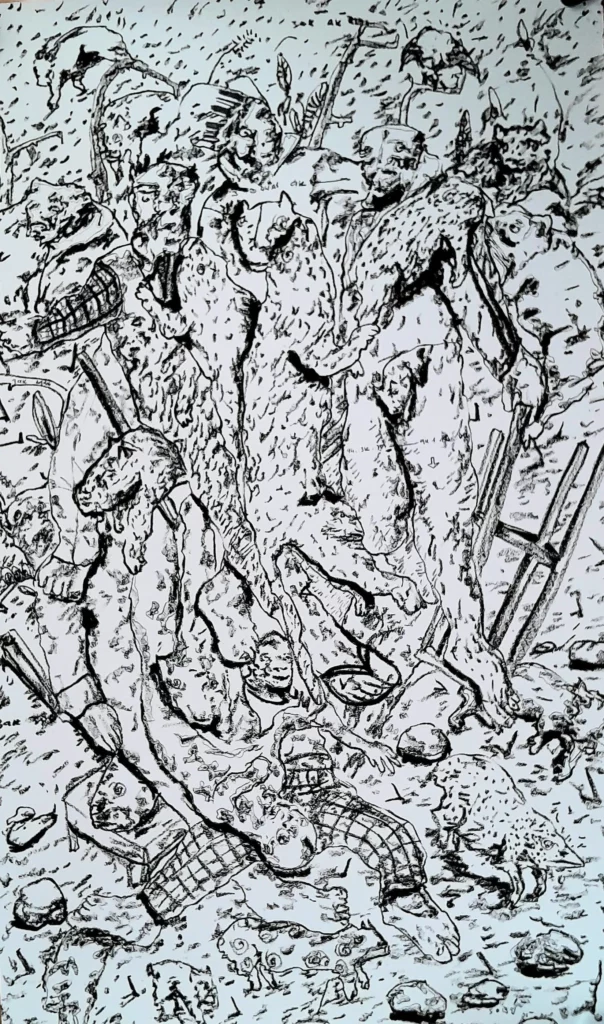
–
En 2001, le critique et historien de l’art Bruno Corà, découvre à Dakar l’œuvre graphique de Soly Cissé : Le Monde Perdu. Il en souligne d’emblée la dimension transculturelle et la complexité, qualifiant ces dessins au fusain de « heureuse invention picturale » qui explore des thèmes à la fois mythologiques et anthropologiques. Le Monde Perdu s’inscrit pout lui dans une tradition d’allégories universelles, en écho aux grandes luttes de l’humanité. L’historien de l’art établit un parallèle avec Les Caprices de Goya, qu’il considère comme le seul précédent occidental par sa densité graphique, inscrivant l’artiste dans une lignée marquée par une vision dramatique et engagée de l’humanité.
On ressent un choc devant la fulgurance du geste de l’artiste qui « arrache » au charbon de bois ses figures dans des enchevêtrements de tracés superposés telles des fresques pariétales surgissant d’un temps suspendu. On pense aux bouleversements des cultures éteintes…Lascaux…Altamira…..la naissance de l’art…les cultes disparus… le début de l’humanité dans l’impressionnante scène d’ouverture de « 2001 : l’Odyssée de l’espace (1968) avec pour générique, la musique de Richard Strauss : « Ainsi parlait Zarathoustra » ou encore les Mondes Perdus de « Jurassic Park » , adapté librement par Spielberg des romans de Michael Crichton, The Lost World, (1990 et 1995), hommage explicite à la nouvelle de Conan Doyle ,The Lost World, (1912).
Entre archéologie et science-fiction, Les Mondes Perdus traversent le XXe siècle comme une métaphore d’un espace hors du temps où résonnent les luttes d’hier, d’aujourd’hui et de toujours.
Les oeuvres de Soly Cissé transcendent les conflits qui les ont inspirés, inscrivant l’artiste dans une longue tradition artistique qui interroge la Condition Humaine.
En 2005, la série Monde Perdu est mise en lumière par Philippe Dagen dans un article du Monde, à l’occasion de l’exposition Africa Remix — organisée par Simon Njami et Laurence Bertrand Dorléac — présentée au Centre Pompidou, après des étapes au Kunstpalast de Düsseldorf et à la Hayward Gallery de Londres.
L’historien et critique d’art souligne: L’impact de l’oeuvre de Soly Cissé réside dans cette capacité à allier des formes très singulières à des enjeux universels, tout en offrant une perspective nouvelle sur la production artistique actuelle.
« Les fusains de la série Monde Perdu de Soly Cissé, Africa Remix, des singularités et des formes universelles », Philippe Dagen, Le Monde, 25 mai 2005.
En 2022, un ensemble d’œuvres graphiques ainsi que plusieurs toiles de l’artiste ont été acquis par le Centre Pompidou,, Paris,
affirmant la reconnaissance institutionnelle de l’ œuvre.
Soly Cissé, dessins, disegni, drawings, 1999-2000 – Crise de la conscience traditionnelle et prémonition de la nouvelle Afrique
publié par Bruno Corà, Prato le 25 avril 2002. Édition trilingue, limitée à 36 exemplaires.
Soly Cissé, le Monde perdu, Centro per l’arte contemporanea, Luigi Pecci, 2005, Prato, Ialie
Bruno Corà est aujourd’hui à la tête de la collection Alberto Burri dans la province de Perouse en Italie.
In 2001, the critic and art historian Bruno Corà discovered Soly Cissé’s graphic work The Lost World in Dakar. He immediately highlighted its the cross-cultural dimension and complexity, describing these charcoal drawings as a “felicitous pictorial invention” that explores both mythological and anthropological themes. For Corà, The Lost World aligns with a tradition of universal allegories, resonating with humanity’s great struggles. The art historian draws a parallel with Goya’s Los Caprichos, which he considers the only Western precedent for its graphic intensity, placing Soly Cissé within a lineage marked by a dramatic and engaged vision of humanity.
Torn from charcoal, as if emerging from a suspended moment in time, we are struck by the artist’s dazzling technique. We think to the upheavals of vanished cultures… Lascaux… Altamira…..the birth of art… vanished cults… the birth of mankind in the impressive opening scene of “2001: A Space Odyssey” (1968), with Richard Strauss’s, “Thus Spake Zarathustra” as the opening theme or The Lost Worlds of “Jurassic Park”, adapted by Spielberg from Michael Crichton’s novels The Lost World (1990 and 1995), an explicit tribute to Conan Doyle’s short story, The Lost World (1912).
Straddling archaeology and science fiction, The Lost World traverses the 20th century as a metaphor for a timeless space where the struggles of yesterday, today, and forever resonate.
Soly Cissé’s works transcend the conflicts that inspired them, anchoring the artist in a long artistic tradition that probes the human condition.
From 2002 onward, Bruno Corà began efforts to promote and bring recognition to Soly Cissé’s graphic work.
In 2005, the Monde Perdu series was brought to wider attention by Philippe Dagen in an article in Le Monde, on the occasion of the Africa Remix exhibition — curated by Simon Njami and Laurence Bertrand Dorléac — presented at the Centre Pompidou, following earlier stops at the Kunstpalast in Düsseldorf and the Hayward Gallery in London.
The art historian and critic emphasized:
The impact of Soly Cissé’s work lies in its ability to merge highly singular forms with universal concerns, while offering a new perspective on contemporary artistic production.
— “The charcoals of Soly Cissé’s Monde Perdu series, Africa Remix, singularities and universal forms,” Philippe Dagen, Le Monde, May 25, 2005.
In 2022, a collection of graphic works as well as several paintings by the artist were acquired by the Centre Pompidou in Paris, affirming the institutional recognition of his work.
Soly Cissé, dessins, disegni, drawings, 1999–2000 – Crisis of traditional consciousness and premonition of a new Africa,
published by Bruno Corà, Prato, April 25, 2002. Trilingual edition, limited to 36 copies.
Soly Cissé, Le Monde Perdu, Centro per l’arte contemporanea Luigi Pecci, 2005, Prato, Italy
Bruno Corà is currently the director of the Alberto Burri collection in the province of Perugia, Italy.



Rejoignez notre liste de diffusion pour recevoir les expositions de la galerie, les avants premiers des projets, les mises à jour sur nos artistes, nos événements.
Galerie Chauvy © 2024, Tout droits reservés –Cookies – Mentions légales – Création Pontonweb